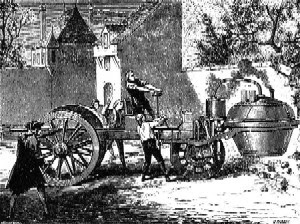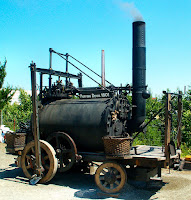The Puffing Devil: A Man-Made Christmas Eve Miracle of 1801 and One Hell of a Hot Ride
Lumbering down Fore Street and then continuing up Camborne Hill to the neighboring village of Beacon, in the cold pouring rain is a cast iron, wheeled contraption that is belching acrid black smoke straight up into the earth’s atmosphere by means of a large vertical pipe.
This is the Puffing Devil: so named by its most remarkable inventor Richard Trevithick. The Puffing Devil is the first ever man made self-propelled wheeled vehicle in the history of the world. It is the precursor to all of today’s cars, trucks and wheeled gas and electric powered vehicles.
It is carrying six passengers, one of whom is Richard Trevithick himself, along with his cousin Andrew Vivian, who is standing just aft the enormous smokestack and steering the devil by means of a cumbersome stick.
For two years Richard Trevithick has labored day and night on his “Road Carriage” and he has now chosen Christmas Eve 1801 as the day to demonstrate his “Puffing Devil” for all the world to see.
 |
| Richard Trevithick (What's he pointing at?) |
Crowds stand aghast as the Puffing Devil moves uphill, on wheels, under its own locomotive power, and heads down the road towards the nearby town of Beacon.
A passenger on the Puffing Devil on that momentous day said in awe of the machine that, “It continued to move up and down hill like a little bird…going faster than I could walk.”
Trevithick recounts of the Puffing Devil’s first trip, mankind’s first ride in an engine powered road vehicle:
“Twas a stiffish hill going up the Weith to Camborne Beacon…when she had gone about a quarter of a mile there was a roughish piece of road covered with loose stone; she didn’t go quite so fast then, and as it was flood of rain, and we were very squeezed together, I jumped off. She was going faster than I could walk and went on up the hill about a half a mile farther when they turned her and came back again.”
The Puffing Devil may not have set any world speed records and it may not have been able to ride across country, but its first momentous trip from one small English town, up a hill to another small English town, and then back again, is a tremendous success and a turning point in modern human history.
It runs by means of a small single cylinder pressure operated piston engine, which is powered by a large horizontal boiler in the shape of a large cylinder. Burning coal and generating smoke at enormously high pressures, 145 PSI (pounds per square inch) the Puffing Devil is able to create enough power to move 7 people relentlessly, if slowly, uphill.
 |
| Contemporary Sketch of The Puffing Devil |
All six passengers sit atop the cylindrical metal boiler for what must have been one hell of a hot ride.
The Puffing Devil is the brainchild, and labor of love of repairman and tin-miner turned inventor Richard Trevithick. Trevithick is an unlikely candidate to build the world’s first engine powered wheeled vehicle then called a Road Locomotive, Road Carriage, or simply, The Puffing Devil due to the clouds of foul smelling black smoke it belches into the sky at regular intervals.
He was born around the year 1770, the son of a tin mining family, as were most of the residents, at that time, who lived in Cornwall in and around the city of Camborne. Trevithick was a terrible student. Years later, after having gained some notoriety for his inventions, former teacher’s of Trevithick would describe him as a, “(D)isobedient, slow, obstinate and a spoiled boy.”
By his own admission Trevithick himself wasn’t much for studying or learning inside of a classroom. In fact, for his entire life Trevithick would remain largely illiterate, however, he always loved to tinker and was known for his practical problem solving abilities. By the age of 20, around the year 1790, Trevithick found himself working in the same tin mines that his father had labored in for his entire life.
The young Trevithick was employed as a “mine engine” repairman where he worked on the machines that helped winch the men in and out of the large mineshafts from which the tin was dug. He observed firsthand the operation of something named the “Cornish” engine which was a steam engine that operated at an extremely high pressure and helped move pulleys up and down, and move mining equipment along tracks.
Trevithick’s work was thankless and hard but he quickly gained an eye for engines and soon began to dream of making his own form of self-propelled steam powered vehicle.
A large charismatic man, a commanding figure who was not averse to throwing punches when necessary, the pragmatic Trevithick was promoted to mine manager within ten years and by the age of thirty everyone in Cornwall referred to Richard as “Captain Dick”.
Using steam power to create a self-propelled vehicle to transport passengers was not an entirely new concept by Christmas Eve of 1801. In fact, James Watt, father of the steam engine itself, held just such a patent during the 1780’s and 1790’s, and it was reported that Watt and his assistant William Murdock made such a machine in 1786.
 |
| Scottish Inventor James Watt |
Apparently, Watt and Murdock tested their machine in the middle of the night one day and were not too successful. Their machine looked like a moving, “garden shed,” and it was said it had caused a local clergyman to faint after believing he had seen the Evil One Himself when he inadvertently stumbled upon Watt and Murdock’s road carriage. The Watt and Murdock vehicle literally went up in smoke, and James Watt went on to perfect steam powered railway locomotives and developed a way to light his home using gas in lieu of creating a self-propelled road vehicle.
When Watt’s patent on the self-propelled “road carriage” expired in 1799, that’s when Trevithick swooped in and began development on the Puffing Devil.
But history has one more claimant who challenges Richard Trevithick’s Puffing Devil as the precursor to today’s modern automobile.
This is Frenchman Nicolas-Joseph Cugnot, who over three decades before “The Puffing Devil” ever made that fateful journey uphill on Christmas Eve 1801, invented something for the French army in 1770 that he called the fardier a vapeur, or steam wagon.
Cugnot’s invention was a giant three wheeled steam powered monster that weighed over two tons. The fardier a vapeur was a long and flat contraption driven by a massive steam engine and designed to pull cannon for the French army. Some consider Cugnot’s creation of 1770 to be more of a steam powered trailer rather than an actual passenger vehicle though it was said that the fardier a vapeur could carry two people and reach a speed of two and a half miles per hour.
However, though Cugnot’s steam wagon was tested by the French army it was considered rather unsuccessful given its heaviness, awkward weight distribution primarily due to its three-wheeled design and inability to travel uphill or off of paved roads. After one test the prototype for the fardier a vapeur was abandoned with the French army expressing only mild interest, and Nicolas-Joseph Cugnot went on to tinker privately on his own with improvements to his fardier a vapeur.
In 1771 Cugnot was jailed by French authorities after crashing a second prototype of his steam wagon into a brick wall on his neighbor’s property in Paris in what is considered to be the world’s first automobile accident.
 |
| Cugnot's First Auto Accident 1771 |
Cugnot would die less than two decades later impoverished and unemployed, a victim of the terror of the French Revolution due his own intellectual pursuits.
Christmas Eve 1801 and the trip between towns by English inventor Richard Trevithick’s Puffing Devil marks, almost without a doubt, the first time in history that passengers were ever carried any considerable distance at speeds faster than walking by a self-propelled motor vehicle on a road.
At the very least the ride of “The Puffing Devil” is the first verifiable trip of that kind due to the fact that it was witnessed by, and written about, by hundreds of people in and around Camborne in Cornwall, England. And in history empirical evidence counts for a lot.
Four days later, this time on December 28, 1801, The Puffing Devil was ready to ride again!
On this day Trevithick steered his lumbering steam powered road carriage uphill one more time and The Puffing Devil began to gain speed yet again, but within moments the engine caught fire! Onlookers screamed and passengers went scrambling for their lives as they ran from the flaming iron wreckage of the Puffing Devil.
The hulk of the vehicle was allowed to burn and smolder on a hillside outside Camborne for hours before local townspeople finally came out and extinguished the flames with water.
Ever indomitable, Richard Trevithick would go on to build another model of his self-propelled steam powered Puffing Devil--The Puffing Devil II. Trevithick would take this one to London and conduct several successful demonstrations for large crowds between 1802 and 1804 in the world’s largest city. But he abandoned the passenger self-propelled carriage project after being unable to raise funds for his manufacture of Puffing Devils on a grand scale after years of trying.
 |
| The Puffing Devil II in London 1804 |
Richard Trevithick would go on to work, like most inventors of the time, on steam engines and rail driven steam locomotives yet again until the end of his life in the 1830’s. Trevithick though, always ambitious and ingenious, would attempt to build a tunnel beneath the Thames River and a railway across Central America in Costa Rica.
Steam powered railway locomotives would continue to dominate travel in the 19th century. Not until almost a century after The Puffing Devil first set out on its momentous journey on Christmas Eve 1801 would mankind once again turn its sights in earnest to inventing and using a practical self-propelled passenger vehicle for transport. But for a brief shining moment in the rain in a small town in southwest England way back on Christmas Eve at the turn of the 19th century inventor Richard Trevithick had been years ahead of his time, and all of us who get into our cars each morning, or ride a bus everyday to get where we need to go, definitely owe him and his “Puffing Devil” a debt of gratitude.





Comments
Post a Comment